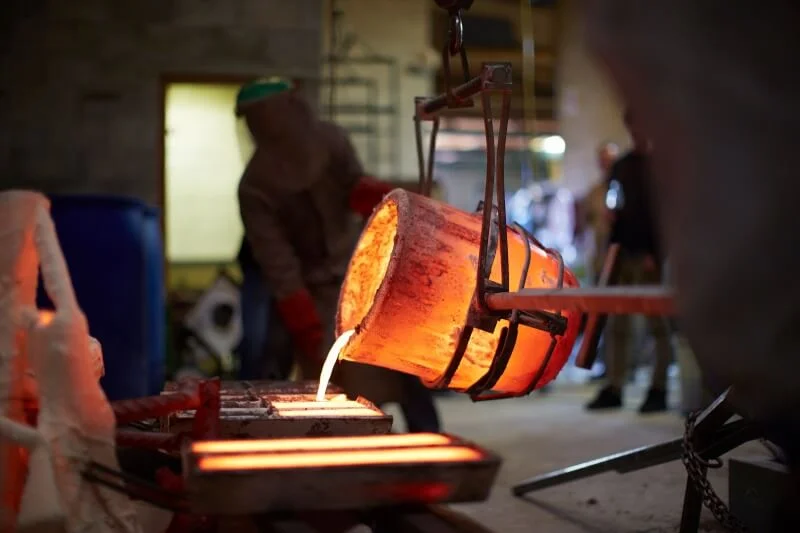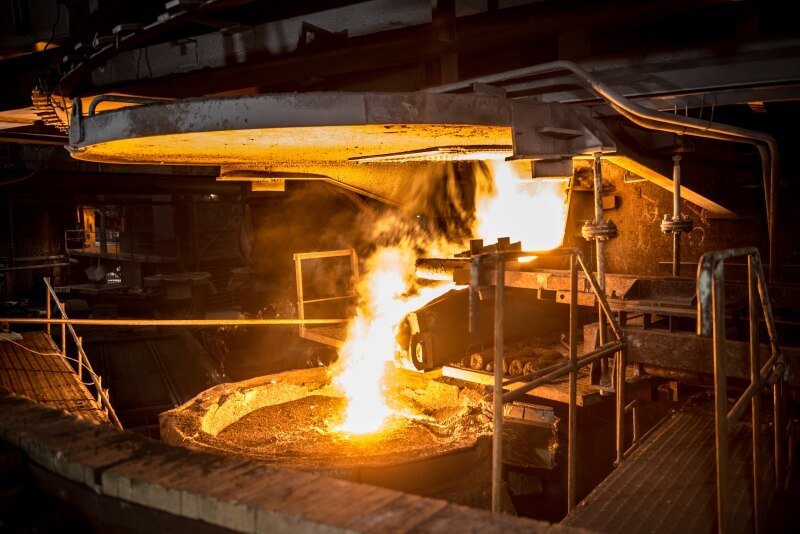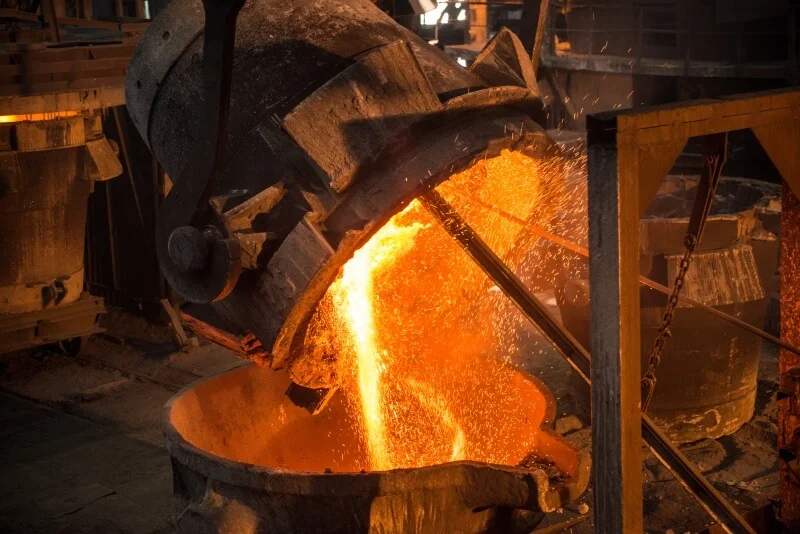Selecting the right aluminum alloy for your die casting project is critical—and the wrong call in casting of aluminum alloys can trigger costly defects, weak performance, and delays that threaten your timeline and budget. This guide gives you a clear path, breaking down the most common alloys so you can confidently choose the ideal material for your specific application.

Process in casting of aluminum alloys
The alloy you select directly impacts the manufacturing process, influencing costs and the likelihood of defects. Two primary concerns are hot cracking and die soldering, which can disrupt production.
What is the hot cracking defect?
This defect is a tear or crack that forms as the molten metal cools and shrinks within the die. What does this mean for you?
- It’s caused by thermal stress during solidification.
- It can appear on the surface or be hidden internally.
How do you understand die soldering?
Die soldering occurs when the aluminum cast part literally sticks to the steel die, making ejection difficult. But that’s not all.
- It can damage both the part and the die.
- It leads to expensive downtime and repairs.
What is the impact on manufacturing?
These defects directly affect your bottom line by increasing scrap rates and causing production bottlenecks. Here’s the deal:
- They force you to discard faulty parts.
- They can halt production for die maintenance.
Key Takeaway: Selecting an alloy with excellent castability from the start is the best way to prevent these costly production issues.
| Defect Type | Description | Primary Cause |
|---|---|---|
| Hot Cracking | Tears or cracks in the cast part | Thermally-induced stress during cooling |
| Die Soldering | Cast part sticking to the die wall | Chemical reaction between aluminum and steel |
| This highlights why process-related alloy properties are just as important as final mechanical properties. |
Product & casting of aluminum alloys
Beyond the casting process, your alloy choice defines the final product’s performance and durability. You must consider its mechanical properties, resistance to its environment, and finishing capabilities.
What are the key mechanical properties?
The fundamentals of strength, ductility, and hardness determine if a part can withstand its operational demands. What does this mean for you?
- Strength: Resists bending and breaking under load.
- Ductility: Can deform without fracturing.
- Hardness: Resists scratches and surface wear.
How important are corrosion and wear resistance?
These properties are critical for a product’s longevity, especially in harsh conditions. But that’s not all.
- Corrosion resistance is vital for outdoor or marine use.
- Wear resistance is key for parts subject to friction.
What about finishing and machinability?
Many parts require secondary operations, and some alloys are much easier to work with after casting. Here’s the deal:
- Common finishes include anodizing and powder coating.
- Good machinability is crucial for creating precise features.
Key Takeaway: You must match the alloy’s end-use properties to your product’s specific application to ensure it performs reliably.
| Characteristic | Description | Importance |
|---|---|---|
| Mechanical Properties | Strength, ductility, hardness | Governs structural integrity and performance |
| Resistance Properties | Corrosion and wear resistance | Determines durability and lifespan in the field |
| Post-Cast Properties | Machinability and finishing | Affects final appearance and cost of secondary operations |
| Choosing an alloy is always a balancing act between these distinct product-focused characteristics. |
A380 casting of aluminum alloys
A380 is the most popular and widely used aluminum die casting alloy for a reason. It offers a great combination of properties that suit a vast range of general-purpose applications.
What are the properties and common uses of A380?
This alloy provides good mechanical properties and is very easy to cast, making it a go-to choice. What does this mean for you?
- It has good strength and wear resistance.
- Common uses include lawnmower housings and hand tools.
Why is A380 so popular?
Its popularity comes from its balanced profile of being easy to work with and providing solid performance. Here’s the deal:
- It has excellent resistance to hot cracking.
- It offers good machinability and thermal conductivity.
What are the limitations of the A380 alloy?
While versatile, A380’s primary weakness is its only fair corrosion resistance, making it unsuitable for some environments. But that’s not all.
- It can degrade in marine or high-moisture conditions.
- Its anodizing quality is good but not excellent.
Key Takeaway: A380 is an excellent default choice for many projects, but you must verify its corrosion resistance meets your needs.
| Property | A380 Rating | Common Application |
|---|---|---|
| Resistance to Hot Cracking | Very Good | Gear Cases |
| Machinability | Good | Workbench Vises |
| Corrosion Resistance | Fair | Lawnmower Housings |
| A380’s profile makes it a cost-effective workhorse for applications where corrosion is not the main concern. |
A360 casting of aluminum alloys
When you need superior corrosion resistance without sacrificing strength, A360 is an outstanding choice. It is a common alternative to A380 for parts exposed to tougher environmental conditions.
What gives A360 its high corrosion resistance?
A360 has lower copper content, which significantly enhances its ability to withstand corrosive elements. What does this mean for you?
- It’s rated as excellent for corrosion resistance.
- It performs well in wet or humid environments.
How does A360 compare to A380?
A360 offers much better corrosion resistance and pressure tightness than A380, but it is more difficult to cast. Here’s the deal:
- A360 Advantage: Superior durability in harsh environments.
- A380 Advantage: Easier and less expensive to cast.
What are the ideal applications for A360?
This alloy is perfect for products that need to remain structurally sound and visually appealing despite exposure to the elements. But that’s not all.
- It’s used for instrument cases and irrigation parts.
- It’s also found in marine components like hinges.
Key Takeaway: Choose A360 when corrosion resistance is your top priority and you can manage a slightly more challenging casting process.
| Property | A360 Rating | Common Application |
|---|---|---|
| Corrosion Resistance | Excellent | Instrument Cases |
| Resistance to Hot Cracking | Excellent | Irrigation System Parts |
| Machinability | Good | Outboard Motor Parts |
| A360 is the clear upgrade for any part where environmental durability is non-negotiable. |
383 casting of aluminum alloys
For parts with complex shapes and fine details, 383 (also known as ADC12) is often a better choice than A380. It is specifically formulated to fill intricate sections of a die more easily.
What are the benefits for intricate parts?
383 has superior fluidity and resistance to hot cracking, allowing it to flow into complex geometries without defects. What does this mean for you?
- It reduces the risk of misruns in thin-walled sections.
- It accurately reproduces fine details from the die.
Where is it commonly used?
You’ll find 383 in a variety of products where both strength and complexity are required. Here’s the deal:
- It’s used for engine brackets and cylinder head covers.
- It’s also chosen for appliances and power tools.
How is its machinability and finishing?
This alloy offers very good machinability, which is a significant advantage for parts needing precise secondary processing. But that’s not all.
- It machines better than A380.
- It takes finishes like anodizing well.
Key Takeaway: If your design is complex or has intricate details, 383 alloy provides a safer, more reliable casting experience than A380.
| Property | 383 (ADC12) Rating | Common Application |
|---|---|---|
| Resistance to Hot Cracking | Excellent | Engine Brackets |
| Machinability | Very Good | Power Tools |
| Common Uses | High | Appliances, Furniture |
| For detailed components, 383 offers a more forgiving and precise casting process. |
A413 casting of aluminum alloys
A413 is a standout alloy from the 4xx.x series, prized for its exceptional pressure tightness. This makes it ideal for components that must contain liquids or gases without leaking.
Why does it have excellent pressure tightness?
Its high silicon content gives it superb fluidity, allowing the molten metal to fill every microscopic void in the die. What does this mean for you?
- It creates dense, leak-proof castings.
- It’s perfect for hydraulic and pneumatic components.
When should you use the 4xx.x series?
This series is generally chosen when die-filling characteristics and pressure tightness are more important than mechanical strength. Here’s the deal:
- They are less prone to hot cracking.
- They are easier to cast into thin-walled parts.
What are its common applications?
You will find A413 used in applications where leaks would cause system failure or safety issues. But that’s not all.
- It’s used for outboard motor pistons.
- It’s also ideal for dental equipment and street lamp housings.
Key takeaway: When your part absolutely cannot leak, A413 is one of the most reliable and effective alloys you can choose.
| Property | A413 Rating | Common Application |
|---|---|---|
| Pressure Tightness | Excellent | Outboard Motor Pistons |
| Resistance to Hot Cracking | Excellent | Dental Equipment |
| Machinability | Fair | Street Lamp Housings |
| A413’s value lies in its superior castability and ability to form leak-proof seals. |
B390 casting of aluminum alloys
When your top priority is extreme hardness and wear resistance, B390 is the specialized alloy for the job. It contains a high percentage of silicon, making it exceptionally durable against friction.
How does B390 achieve high wear resistance?
The high silicon content forms hard particles within the aluminum matrix, creating a very tough surface. What does this mean for you?
- It withstands constant friction and abrasion.
- It is perfect for parts in high-wear mechanical systems.
Where is it used?
B390 is primarily used in internal combustion engines where parts endure intense, continuous wear. Here’s the deal:
- It’s specified for pistons and engine blocks.
- It is also used for brake cylinders and manifolds.
What are the casting challenges with B390?
The same high silicon content that provides wear resistance also makes the alloy more abrasive and difficult to machine. But that’s not all.
- It has only fair resistance to hot cracking.
- It can cause more wear on tooling and dies.
Key Takeaway: Use B390 only when exceptional wear resistance is a critical design requirement that outweighs its casting and machining challenges.
| Property | B390 Rating | Common Application |
|---|---|---|
| Wear Resistance | Excellent | Engine Pistons, Blocks |
| Resistance to Hot Cracking | Good | Manifolds, Cylinder Heads |
| Machinability | Fair | Brake Cylinders |
| B390 is a purpose-built alloy for the most demanding high-wear applications. |
518 casting of aluminum alloys
518 is a specialty alloy known for its excellent corrosion resistance and superior finishing characteristics. It is the top choice when aesthetics and surface quality are paramount.
Why does it have superior finishing characteristics?
The alloy’s composition, rich in magnesium, allows it to achieve a bright, clean finish after anodizing. What does this mean for you?
- It’s ideal for high-quality decorative parts.
- It also boasts excellent machinability.
Where is it used?
You’ll find 518 in applications where the part must withstand the elements while maintaining a pristine appearance. Here’s the deal:
- It is used for marine and aircraft hardware fittings.
- It’s also popular for architectural castings and conveyor parts.
What is its main weakness?
The biggest drawback of 518 is its poor resistance to hot cracking, which makes it very difficult to cast. But that’s not all.
- It requires careful process control to avoid defects.
- This difficulty can increase production costs.
Key Takeaway: Choose 518 when a beautiful finish and corrosion resistance are your main goals, and you’re prepared for a challenging casting process.
| Property | 518 Rating | Common Application |
|---|---|---|
| Anodizing (Appearance) | Excellent | Architectural Castings |
| Corrosion Resistance | Excellent | Marine Hardware Fittings |
| Resistance to Hot Cracking | Poor | Conveyor Parts |
| 518 delivers unmatched aesthetics and durability, but at the cost of increased casting complexity. |
Choice in casting of aluminum alloys
There is no single “best” alloy for every project. The right choice depends on you carefully considering your project’s unique demands and finding the material that best balances them.
How do you choose the right alloy?
Start by ranking the most important characteristics for your part, from mechanical strength to final appearance. What does this mean for you?
- List your “must-have” properties.
- Identify which properties you are willing to compromise on.
How do you balance cost vs. performance?
A more expensive alloy with superior properties may actually save you money by preventing field failures or recalls. Here’s the deal:
- Don’t just look at the raw material cost.
- Factor in manufacturability and long-term durability.
What are some project-specific considerations?
You must analyze the specific environment and stresses your part will face to make an informed decision. But that’s not all.
- Will it be exposed to moisture or saltwater?
- Does it require intricate details or high strength?
Key Takeaway: A thoughtful, priority-based approach to alloy selection is the best way to ensure your project’s success.
| Consideration | Question to Ask Yourself | Example Alloy Choice |
|---|---|---|
| Performance | What is the most critical property? (e.g., wear, corrosion) | B390 for wear, A360 for corrosion |
| Castability | How complex is my part’s design? | 383 for intricate parts |
| Cost | What is my total budget, including potential scrap? | A380 for general-purpose cost-effectiveness |
| This decision framework helps you move from a broad list of options to a specific, justified choice. |
Defects in casting of aluminum alloys
Even with the right alloy, casting defects can still occur if the process is not properly controlled. Understanding how to prevent common issues like hot cracking and die soldering is key.
How do you avoid hot cracking?
The best defense is selecting an alloy with a high rating for hot cracking resistance from the start. What does this mean for you?
- Alloys like A380, A360, and 383 are excellent choices.
- Poor choices, like 518, require expert process control.
What are methods to prevent die soldering?
Preventing the cast part from welding to the die involves both material choice and process adjustments. Here’s the deal:
- Choose alloys with high anti-soldering properties.
- Use appropriate die coatings and temperatures.
How important is quality control in casting?
Vigilant quality control is non-negotiable for producing reliable, defect-free parts. But that’s not all.
- It begins with informed alloy selection.
- It continues with monitoring every step of the casting process.
Key Takeaway: Preventing defects is a combination of smart material selection and rigorous process control.
| Defect | Prevention Method 1: Alloy Choice | Prevention Method 2: Process Control |
|---|---|---|
| Hot Cracking | Select alloys with “Excellent” or “Very Good” resistance (e.g., A360, A380) | Optimize cooling rates and die design |
| Die Soldering | Select alloys with good anti-soldering properties | Apply die release agents and control die temperature |
| A proactive approach to defect prevention saves significant time and money. |
Conclusion
Choosing the right aluminum die casting alloy doesn’t have to be a source of frustration. By understanding the trade-offs between castability, performance, and cost, you can select the ideal material for your needs. If you’re ready to move forward with a partner who understands these nuances, we’re here to help you get it right. Precisionvast is committed to delivering high-quality, reliable components that meet your exact specifications.
FAQ Section
1. What’s the best all-around alloy for casting of aluminum alloys? Generally, the best choice for a versatile, all-around alloy is A380. It offers a great balance of castability, mechanical properties, and cost-effectiveness, making it suitable for a wide range of applications.
2. Can I use a die-cast alloy for parts exposed to saltwater? Yes, absolutely. For saltwater exposure, you should choose an alloy with excellent corrosion resistance, such as A360 or 518, as they are specifically designed to withstand harsh marine environments.
3. What’s the main difference between the A380 and A360 alloys? The primary difference is corrosion resistance. A360 has excellent corrosion resistance, making it ideal for outdoor or wet applications, while A380’s is only fair; however, A380 is typically easier and cheaper to cast.
4. How do I prevent my casted part from cracking during production? The most effective way is to select an alloy with a high resistance to hot cracking. Alloys like A380, A360, and 383 are excellent choices because they are less susceptible to cracking as they cool.
5. What’s the best alloy if my part needs to be very durable and wear-resistant? For maximum wear resistance, B390 is the definitive choice. Its high silicon content makes it extremely hard and durable, perfect for high-friction applications like engine pistons and cylinders.




